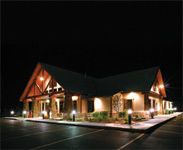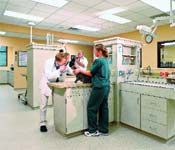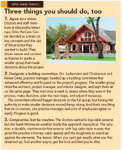Small-practice warmth; big-time convenience
For 87 Years, Alexandria Veterinary Clinic PetCare Center in Alexandria, Minn., served large and small animal clients in a warm, homey atmosphere. Sure, the facility faced changes and a couple of facelifts along the way, including a remodel in 1983 and an addition in 1995. But in 2000, the six owners decided they'd run out of space.
For 87 Years, Alexandria Veterinary Clinic PetCare Center in Alexandria, Minn., served large and small animal clients in a warm, homey atmosphere. Sure, the facility faced changes and a couple of facelifts along the way, including a remodel in 1983 and an addition in 1995. But in 2000, the six owners decided they'd run out of space.

They considered overhauling the old facility, but quickly realized it would They considered overhauling the old facility, but quickly realized it would cost too much to do everything they wanted to do. In the end, building a brand-new facility would give them a more perfect practice. Just one thing gave them pause.
"We needed room to grow, but we wanted to retain the homey atmosphere that the smaller clinic offered," says co-owner Dr. Mark Christenson. "It's hard to do that when you go from a small space to a much larger clinic, but that was our goal. We wanted our philosophy about developing warm relationships with clients to be what ruled our design."

Reception: Three seating alcoves, a fireplace, wood beam trusses, and a greeter's station instead of a check in and checkout desk help make clients' experiences pleasant.
The owners agree that the details made the difference in achieving this goal. A fireplace and greeters set the tone in the reception area. And log-cabin style trusses at the entryway set a theme that's repeated on the practice sign, in the reception area, on the benches, above the fireplace, and in the luxury boarding suites to develop a warm, log-cabin look and an image of a homey practice that caters to clients.
One year later, the doctors say they still have room to grow into their building, clients love the changes, and they continue to add new services. As a bonus, Alexandria Veterinary Clinic PetCare Center was chosen as a 2006 Veterinary Economics Hospital Design Competition Merit Award winner. Design competition judges lauded the practice for the high-quality appearance of the exterior and reception area, the use of a greeter station, the repeated log theme, and nice windows throughout for easy visual contact.
Teamwork personified
Six co-owners, one practice manager, and numerous employees meant a lot of opinions about how a facility should be built. Luckily, everyone agreed on the big points and allowed a select committee to decide on smaller issues.

Alexandria Veterinary Clinic PetCare Center
Early on, the owners chose three owners—Drs. Ledermann, Luckemeyer, and Christenson—and Renee Deitz, the practice manager, to lead a building committee. The committee met once a week over the course of the project to discuss their progress, make decisions, and figure out what steps to take next. The group took charge of hiring an architect, project manager, and interior designer, then acted as go-betweens for these professionals and the rest of the veterinary team.
"The committee made less-major decisions alone, and took larger decisions to the group to develop consensus," says co-owner Dr. Florian Ledermann. "We were lucky that the people we hired understood the process and the details so well, especially our designer, Mary Stedman, because six owners never could have agreed on such details without someone helping us see what was best for our practice. These people were fun to be around and that made the whole process much easier."
To make sure all participants were on the same page, the doctors chose central themes as the basis for the entire project. "As a group, we agreed that we wanted to focus on nature and comfort," says Dr. Ledermann. "From there, the rest of the project came together easily, and the team gave us latitude to make decisions, not consulting them on every little detail."
The practice owners also credit Deitz for doing much of the legwork—and for allowing them time to practice in the midst of a busy design process. "If Renee hadn't been here, we wouldn't have gotten much work done," says Dr. Christenson. "She invested a lot of time in the project."
Deitz, who has been with the practice since 1976, has a little experience with building, though on a more personal level. "I've built a couple of homes with my husband, and we did much of the work ourselves, so I was comfortable checking workmanship and working with the project manager," she says. "It was a great advantage that we built on the same property as the old facility, so I was on site and could make decisions quickly and act as a mediator between contractors and doctors. That kept the project moving smoothly."
Another benefit to being on the same property was that Deitz took staff members through periodic walk-throughs during construction to familiarize them with the layout of the new facility and the location of equipment and supplies. "There were no surprises when we moved in," she says. "Everyone had a clear vision of our new building."
To simplify the moving process, one person was assigned to be in charge of each room. That person led a team through moving the items from the old facility to the new one, then trained them on the area once moved, making for an easy transition, Deitz says.
Protect against the elements
Building in Minnesota meant figuring out a way to protect the building—and clients, pets, and staff members—from the frigid temperatures and heavy snows. Much like those in the South must consider hurricanes and Midwesterners must shore up their buildings against tornadoes, Northerners must worry about heavy snow that builds up on roofs and those arctic winds that blow through the front door.

Treatment area: The Hospital Design Competition judges complimented the treatment area for being clean, organized, and spacious. The area includes four treatment stations and two dental stations. Capping the utility columns three feet above the treatment table surfaces helps the area feel more open.
"Designing to address the requirements of harsh winter conditions called for some unique architectural elements," says architect Mark Hafen, AIA, of Animal Arts/Gates Hafen Cochrane in Boulder, Colo. "For example, we used a steeply pitched roof to help shed snow and prevent the snow drifts that have the potential to build behind parapets and mechanical units on flat roofs." Hafen and his crew also built a stone wainscot that extends around the perimeter of the hospital to prevent damage to the walls from standing snow.

Exam rooms: A greeter escorts clients directly to exam rooms upon arrival. The four standard exam rooms and two family-sized rooms feature a one-wall configuration with a twist: The client seating is across the room from the exam table to give technicians and veterinarians more room to move.
Other weather-related design features include deep roof overhangs and a generously sized vestibule. The vestibule is especially critical because the hospital needed to face north, into the bitter winds.

Staff lounge and conference area: This room includes a kitchen and is large enough to accommodate hospital-wide meetings.
To improve the practice's wind protection, they planted several 16-foot evergreens, Dr. Ledermann says. "They're beautiful and they also protect against sun in the summer," he says. "And the combination of such things as high-efficiency furnaces and facility design really helped our heating and cooling costs."

Three things you should do, too
New facility + new services = healthier pets
"With a new facility comes a new confidence in your quality of medicine—and in the type of medical services offered," says Dr. Ledermann. "Today we have an orthopedic surgeon visit once or twice a month. In the old facility, that was something we didn't feel we had the sterility and ventilation to do."

Doctors' and technicians' stations: This area is centrally positioned and designed with windows to give easy visual access to all hospital functions. The lab and pass-through pharmacy sit along the same hallway for easy access.
A dermatologist also visits regularly. And the doctors added an intensive care unit, something that isn't very common in upstate Minnesota. A hydraulic table rounds out the new equipment list.
"We designed our facility to be good for everyone who works here by including nice flooring, good air quality, and awesome lighting," says Dr. Christenson. "Dr. Luckemeyer, a partner who's been with the practice for 33 years, even designed hydraulic dental tables. The practice also uses portable lift tables so we can pick up patients and roll them into surgery prep, into surgery, and back to recovery—all on one table."
The new high-tech tools and new services reflect the team's ongoing emphasis on high-quality care for patients and clients, say the owners. The new facility just gives the added benefit of more confidence, more space, and a better place to work.
"We tried to create a facility that offers a warm environment for clients and a work environment where we can practice outstanding veterinary medicine," says Dr. Christenson. "Now we have that facility, and we're still striving to make practice better each and every day."

Business office: Located behind the greeter's station, this office lets two employees handle calls and other tasks that often fall to those at the reception desk. This gives those handling business issues more privacy and focus, while another employee greets and escorts clients throughout the hospital visit.
Sarah A. Moser is a freelance writer and editor in Olathe, Kan. Please send questions or comments to: ve@advanstar.com





